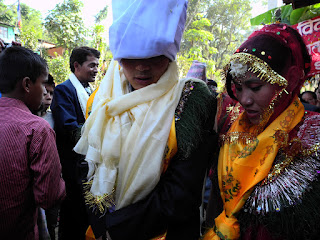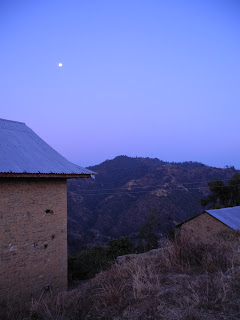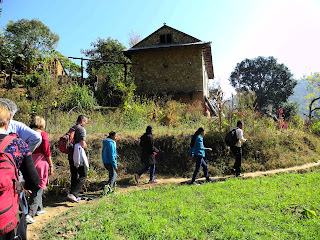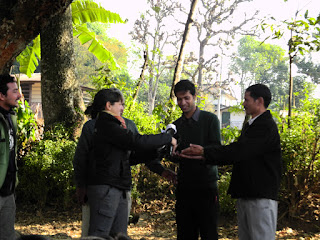Since leaving the monastery and Kathmandu two weeks ago, it has been non-stop, action-packed travel and adventure mixed in with a good number of school visits and talking with kids (and adults) about astronomy. It's been wonderful to have a little more independence, deciding where I go and what I do while still having support from Sudeep and the Nepal Astronomical Society to make strides in my project and make my time here meaningful.
My first stop when I left Kathmandu was back to Panauti, in the Joining Hands orphan home, where I went in my first week in Nepal (technically couch surfing). The orphan home was started by Eric from the U.S. and Himal from Nepal. Himal is one of 11 siblings and I was invited to attend the marriage ceremony of one of his brothers in their remote home village. Going to the wedding consisted of a lot of travel on bumpy Nepali roads, but the ceremony was gorgeous, as was the village.
 |
| Bride and groom leaving the bride's village. |
 |
| In the groom's village, with the bride and groom receiving gifts and tika from family and friends. |
The marriage ceremony lasted through the night, but I eventually went to bed partially because of exhaustion, but mostly because if I sat still for too long another giant plate of food appeared in front of me, and there's really only so much I can eat. When I woke up the next morning just before sunrise (as is my habit in Nepal), Venus was visible through the window, motivating me to get up and walk around. The village is the most picturesque place I've been to in Nepal, as you can see by these photos:
 |
| Village + moon |
 |
| View of the entire village from the next hilltop. |
The group I was with then took the day to walk through the hills back to Panauti. The walk (hike?) took all day and it was great to see more of the countryside on foot.
 |
| Over some rivers and through the hills, back to Panauti we go... |
After being in Panauti for another day, I traveled with two of Himal's brothers to Pokhora, a lakeside town covered in tourists and tourist activity, but also with great mountain views and much less chaos and pollution than Kathmandu. On the second day I arrived, I met up with Suman Gautam from the Pokhora Astronomical Society and visited two schools. First, we went to a public school and spoke with a group of 120+ students in grades 9 and 10. Many had said that private schools in Nepal were much worse than private schools, but the only difference I noticed was larger class sizes. Besides this, though, the students asked the same questions and seemed to have the same basis of astronomy knowledge.
 |
| Talking to hoards of students about astronomy |
 |
| Public school in front of the Himalayas |
The second school we went to in the afternoon was a private English boarding school (although I saw the students go home at the end of the day). My presentation here was part of a larger program by the Pokhora Astronomical Society with an audience of 200-300 students, grades 6-8. As I mentioned in my previous post, during my school visits, I often only get responses and questions from a few select students who like astronomy and therefore have a greater basis of knowledge. During this visit, I wanted to know the ideas from a variety of students, and so I asked each of them to answer 5 basic questions about astronomy: 1.) What is a star and how is it made? 2) What is a planet and how is it made? 3) What other things exist in the Universe besides planets and stars? 4) How was our Universe made? and 5) What questions do you have about astronomy? Here's a sample response:
 |
| Sample response to astronomy questions. Note the response to question 5. |
I told them it was fine to say they didn't know the answer, or just to make it up. It was really interesting to see a full range of responses and get ideas from all of the students, not just the few who participate. Many students knew the terminology, but not necessarily the processes. For example, students usually said that stars were "heavenly bodies" made of gas, but didn't know how they formed. Many said the Universe was made by the Big Bang, but didn't know what that was, or thought that it was when a star exploded and created planets. The things that were repeated the most often were words or definitions that seemed to be memorized, not well-understood. This seems representative of the education system here, which is more focused on memorization and regurgitation of facts as opposed to a more analytic understanding of the subject matter.
After a day of rest enjoying the views of the lake and mountains in Pokhora, I met up again with Sudeep and his friend Manoj. The three of us journeyed to host a star party in Phalebas, a village a few hours away from Pokhora. The area was rural, but by no means as remote as the village I went to for the wedding. We were unsure how publicized the star party would be, and thought maybe a dozen people would attend. Instead, over 200 people showed up! Mostly the people who came were older boys, but there were also some girls, younger students and adults from the village. It was so chaotic, especially with only two small telescopes, but most of the people who came had the chance to see Jupiter and the Galilean moons.
 |
| To Phalebas! |
 |
| Hoards of students at the star party. |
The next day we visited the 11th grade science class and spoke with the students about astronomy. This school is just introducing science into the curriculum for the first time, and the students here had very little prior knowledge about astronomy. I decided this was the best place to leave the Galileoscope and tripod given to me in La Serena. Hopefully by having this small tool, the teachers can motivate the students as they start to learn science in school.
 |
| Showing the physics teacher how to focus the Galileoscope. I was generously given this telescope (and tripod!) in Chile, and now it has a happy and permanent home in Phalebas. I can only hope that it helps inspire students to learn more about astronomy in the years ahead. |
 |
| The official handing over of the telescope. |
 |
| Receiving tika as a traditional thank you |
On the journey to and from Phalebas, we also stopped and chatted with local people about astronomy, as the telescopes and tripod we carried probably seemed odd to the locals. When we asked what they knew about astronomy, people mentioned constellations they can see and also alluded to the Nepali astronomy/astrology traditions. I spoke with Sudeep and Manoj more about these traditions as we walked, and they explained how each naked-eye object in the ecliptic (Sun, Moon, Mercury, Venus, Mars, Jupiter and Saturn) plus two "nodes" in the ecliptic are considered gods. The placement of these gods at birth determines a person's fortune, which is how my future was read by Shivraj the astrologer in Kathmandu. Additionally, people pray to these gods to show respect and ensure good fortune. Very interesting to learn about as different ways that people here connect with the Univserse.
After returning from Phalebas, I spent a few lovely days hanging out in Pokhora, eating well, doing yoga, hiking, exploring the area, and meeting up with other travelers and friends. Now I'm back in Kathmandu with only a few days left here in Nepal. I'm planning to do one more school visit, and will also be just spending time running errands and preparing for my trip to South Africa!
Thanks for reading! Oh, and for the record,
Gumba means "to go around" in Nepali. The title of this post is a thus the English-ization often by my friend Eric, as in, "So, what's the plan for today?" "Oh, you know, eating, reading, gumba-ing." Since I've been going around Nepal and doing many things these past few weeks, it seemed to be a fitting title.


